Switzerland: Franc depreciation would boost growth
The Swiss economy has not looked this good since the exchange rate floor against the euro was abolished at the beginning of 2015. The recovery gained momentum and became widespread in the second half of 2017. For 2018, we expect strong GDP growth of 2.3%, after 1% in 2017
The end of 2017 was strong and it should continue in 2018
For the year 2017 as a whole, manufacturing contributed the most to growth. The service sector also contributed positively to GDP growth in late 2017 after a slowdown at the beginning of the year. As a result, GDP growth was recorded at 0.7% quarter on quarter in 3Q and 0.6% in 4Q, the best performance since 2014. This dynamic economic development is due to both internal and external factors. Indeed, the healthy global economy is boosting international demand for Swiss products and therefore driving foreign trade, while investment is stimulating domestic demand.
For the future, leading indicators suggest the Swiss economic expansion will continue in the near term. The KOF economic barometer, the leading indicator of the Swiss economy, started the year on a strong note though it fell in March to 105.1 from 108.4 in February, dampened by rising pessimism within the export sector due to President Trump’s protectionist policy announcements. It has started to rebound in April, however, and we expect a continued rise if fears of protectionist policies stabilise. PMI indicators are still above 60, which has not been the case since the start of the financial crisis.
Separately, Swiss national accounting recently started to reveal the effects on GDP of large sporting events, such as international football competitions and the Olympic Games. These events result in the sale of TV rights and increase the revenues of entities domiciled in Switzerland, and they have given a short-term boost to GDP growth each time they occurred. In 2018, the effect is estimated by the KOF institute to add 0.3 pp to GDP growth.
Leading indicators suggest that economic expansion will continue in the near term
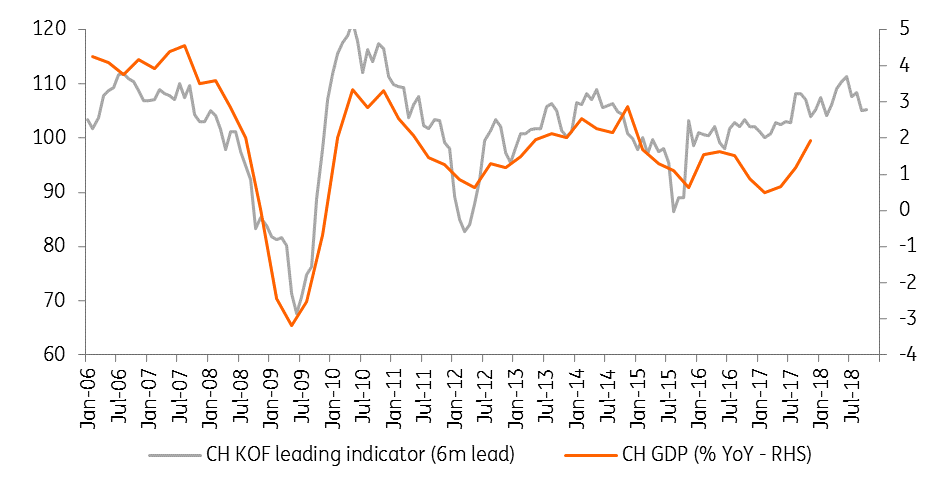
Strong GDP growth expected and balanced risks
All in all, we expect strong GDP growth of 2.3% in 2018, after 1% in 2017. GDP growth is expected to stabilise at 2.0% in 2019. Positive and negative risks for the Swiss economy are well balanced. On the one hand, a further Swiss franc depreciation would give the Swiss economy on additional boost. On the other hand, protectionist measures and political uncertainty in the EU (notably Italy and Brexit negotiations) are negative risks for the Swiss economy given its openness. Turbulence on financial markets remains a risk for Switzerland as it could create further upward pressure on the Swiss franc, a traditional safe haven. Internally, the real estate sector could still be a risk given that the number of new constructions is increasing, while the vacancy rate continues to grow. However, the decline in rents is expected to accelerate indicating that the risk of a housing bubble is diminishing.
| 2.3% |
GDP growth in 2018ING’s forecast |
Foreign trade would provide a significant boost to growth
Thanks to the dynamic foreign economy, which is strengthening demand for Swiss intermediate and final products, and the real depreciation of the Swiss franc since mid-2017, exports contributed positively to growth in the fourth quarter 2017. We believe the Swiss Franc could depreciate further this year and in 2019. Indeed, the Swiss franc depreciated strongly since the beginning of 2018 and EUR/CHF reached 1.20, the former floor, in April 2018. We expect this trend to continue, reaching 1.25 EUR at the end of 2018 and 1.30 at the end of 2019. Exports are likely to see robust and broad-based growth over the coming quarters. Exports that are sensitive to the global business cycle and exchange rates, such as machines, metals and tourism, look set to enjoy particularly dynamic growth. Imports are also expected to show solid growth over the forecast period given the large share of imported inputs in exports and the increase in domestic investment activity. Overall, we expect that foreign trade will provide a significant boost to growth in 2018 and in 2019.
Net exports contributed positively to growth

The upward trend in business investment is set to continue
Together with net exports, investment was one of the main drivers of growth in 2017. In keeping with the international climate, the upward trend in business investment is set to continue during the forecast period. Indeed, as a result of the cyclical recovery, the use of production capacity has increased strongly and, according to the KOF Industry Survey, is now again above the long-term average for the first time since the end of 2011. The increasing use of production capacity is likely to encourage companies to invest in their expansion. Moreover, the KOF industry survey indicates that industrial companies’ order books seem to be well filled, at the highest level in 10 years. Industrial production and expected production indicators are also at the highest point since 2011. All in all, we believe business investment will grow at a fast pace in 2018 and 2019.
Increasing use of production capacity would boost investment
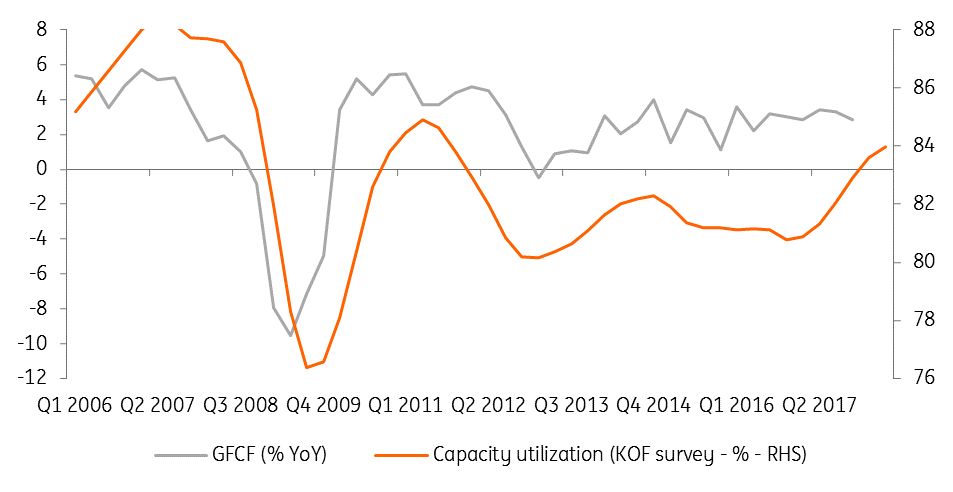
Only a moderate rise in consumption is expected
In 2017, growth in consumer spending amounted to +1.2%. The pace has therefore slowed significantly compared to the previous two years (1.8% in 2015 and 1.5% in 2016). Even though consumer confidence was high compared to 2015 and 2016, modest nominal wage developments, higher prices reducing the real purchasing power of households and a sluggish labour market weakened consumption in 2017. For 2018, we expect only a moderate rise in spending. On the one hand, leading indicators on the labour market suggest that the situation is improving again which would push wages up and increase consumption. In addition, consumer confidence is high and above its long-term average. On the other hand, since inflation is set to increase a bit more in 2018, we don’t expect to see much of an increase in real wages in the short term. The pace of consumption growth would then consolidate further in 2019.
Improved situation on the labour market
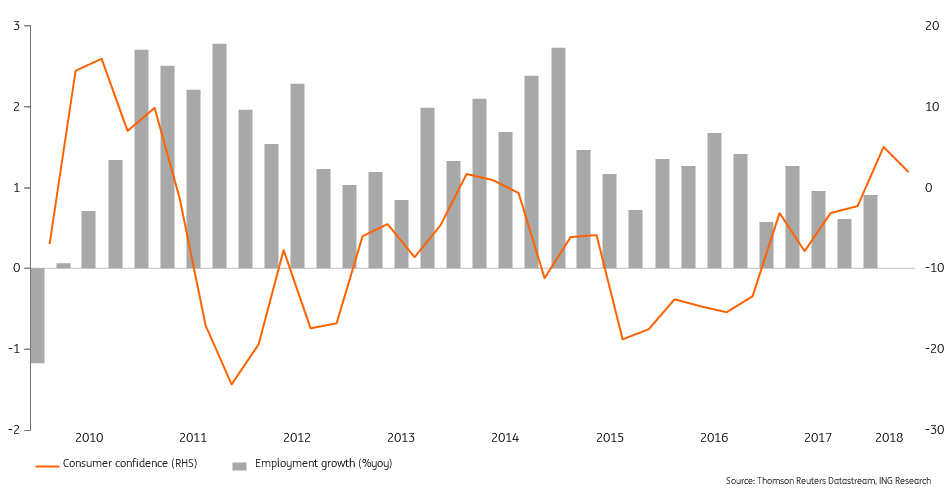
| 0.7% |
ING’s forecast for CPI inflation in 2018 |
Inflation is expected to rise a bit
After a long deflationary period, CPI inflation has been in positive territory since January 2017, thanks to higher energy prices and the CHF depreciation in the second half of the year, which made imported goods more expensive. After having reached a level of 0.5% in 2017, CPI inflation is expected to rise to an annual average of 0.7% in 2018. While a lower VAT rate, adjusted medical services tariffs and diminishing rent prices could put downward pressure on inflation in 2018, rising oil prices and further CHF weakening would push up import prices, which are expected to further contribute to inflation. In addition, given the favourable economic situation, domestic price pressures should gradually increase as well because companies will have more opportunity to raise prices. All in all, inflation is set to climb to a modest 0.7% in 2018 and reach 1% in 2019.
Positive outlook for core inflation
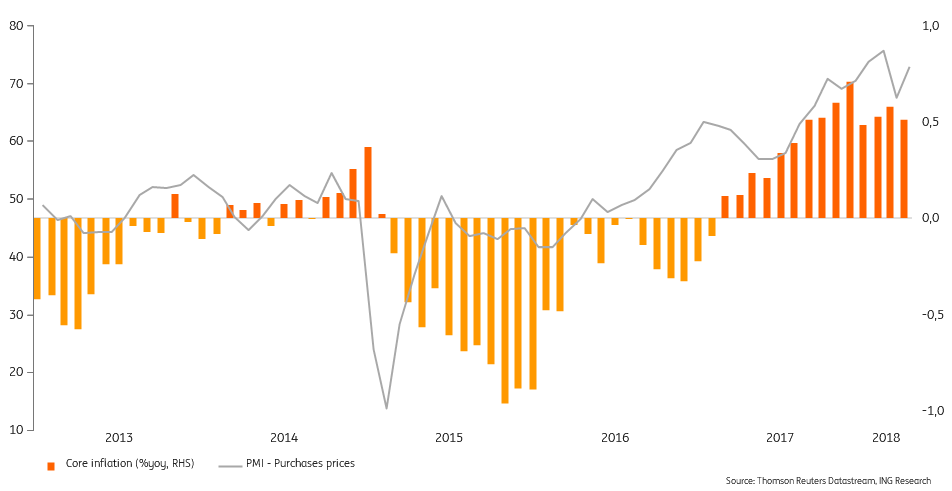
An unchanged monetary policy in March
The Swiss National Bank (SNB) decided in March to keep its main interest rate unchanged at -0.75% on sight deposit and the target range for the three-month Libor at between -1.25% to -0.25%. President Thomas Jordan reiterated during the press conference that the SNB “will remain active in the foreign exchange market as necessary while taking the overall currency situation into consideration”. The SNB still thinks that “the franc remains highly valued”. The SNB also believes that “the situation in the foreign exchange market is still fragile and monetary conditions may change rapidly”, justifying no change in its interventionist stance.
This shows that the SNB remains very cautious about declaring victory on deflation, but is still eager to show that getting back to the 2% target in the medium term is possible. Indeed, we see a possibility that a weaker exchange rate in the next few months will lead to better growth and higher inflation, at 1% in 2019.
The current inflation numbers are unlikely to allow for any monetary tightening before late 2019. In order to avoid an appreciation of the CHF against the EUR, which could reduce inflation, we think the SNB won’t start to tighten before ECB starts increasing interest rates, which is not expected before June 2019. Still, a stronger economic outlook and some inflationary pressures should eliminate any risk of further easing measures.
We therefore think that the SNB will keep negative interest rates intact until late 2019 and will refrain from any further FX intervention while staying open to the possibility of intervention in case risk-aversion returns. All in all, the current policy mix still looks very stable for the SNB. This should allow the CHF to depreciate further in 2018 and 2019.
CHF on a depreciation track
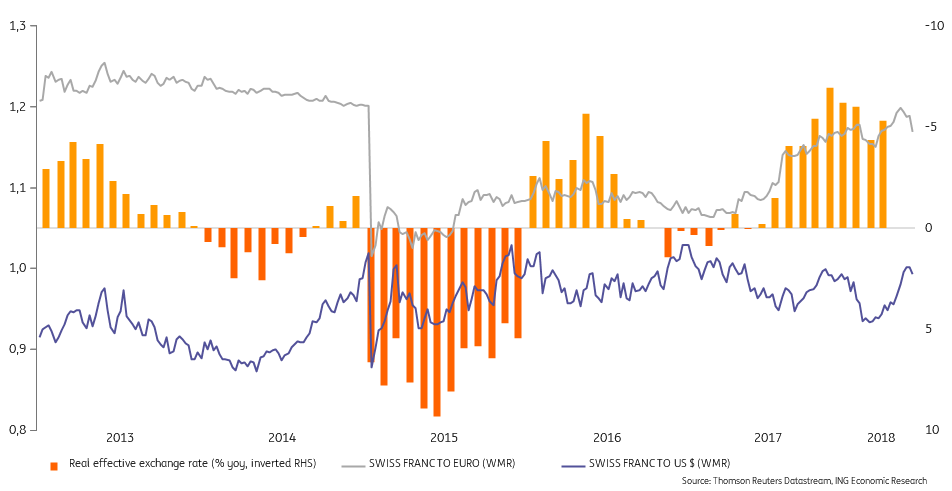
Referendum on the monetary system
On 10 June, Switzerland will have a referendum on the introduction of the “Vollgeld initiative”, promoting a sovereign money system where only the SNB can issue money. While we believe the proposal is unlikely to be adopted, we cannot exclude some nervousness in the run-up to the popular vote, as a yes vote would have a negative impact on Swiss GDP and the monetary system. Indeed, a “yes” would require a complete overhaul of the current monetary system. It would cause insecurity and could harm the financial centre and, thus, Switzerland as a whole. It is almost impossible to anticipate the consequences of such a new experiment on the Swiss economy for now. But in a first instance, it would probably lead to a further weakening of the CHF. The risk for the conduct of monetary policy is thus worth flagging.
The Swiss economy in a nutshell (%YoY)
This publication has been prepared by ING solely for information purposes irrespective of a particular user's means, financial situation or investment objectives. The information does not constitute investment recommendation, and nor is it investment, legal or tax advice or an offer or solicitation to purchase or sell any financial instrument. Read more
